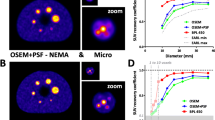Abstract
The optimal injection dose for imaging of the pelvic region in 3D FDG PET tests was investigated based on the noise-equivalent count (NEC) rate with use of an anthropomorphic pelvis phantom. Count rates obtained from an anthropomorphic pelvis phantom were compared with those of pelvic images of 60 patients. The correlation between single photon count rates obtained from the pelvic regions of patients and the doses per body weight was also evaluated. The radioactivity at the maximum NEC rate was defined as an optimal injection dose, and the optimal injection dose for the body weight was evaluated. The image noise of a phantom was also investigated. Count rates obtained from an anthropomorphic pelvis phantom corresponded well with those from the human pelvis. The single photon count rate obtained from the phantom was 9.9 Mcps at the peak NEC rate. The coefficient of correlation between the single photon count rate and the dose per weight obtained from patient data was 0.830. The optimal injection doses for a patient with weighing 60 kg were estimated to be 375 MBq (6.25 MBq/kg) and 435 MBq (7.25 MBq/kg) for uptake periods of 60 and 90 min, respectively. The image noise was minimal at the peak NEC rate. We successfully estimated the optimal injection dose based on the NEC rate in the pelvic region on 3D FDG PET tests using an anthropomorphic pelvis phantom.







Similar content being viewed by others
References
Czernin J, Allen-Auerbach M, Schelbert HR. Improvements in cancer staging with PET/CT: literature-based evidence as of September 2006. J Nucl Med. 2007;48(Suppl 1):78S–88S.
Everaert H, Vanhove C, Lahoutte T, Muylle K, Caveliers V, Bossuyt A, et al. Optimal dose of 18F-FDG required for whole-body PET using an LSO PET camera. Eur J Nucl Med Mol Imaging. 2003;30:1615–9.
National Electrical Manufacturers Association. Performance Measurements of Positron Emission Tomographs. NEMA Standards Publication NU 2-2001. Rosslyn: National Electrical Manufacturers Association; 2001.
Bettinardi V, Danna M, Savi A, Lecchi M, Castiglioni I, Gilardi MC, et al. Performance evaluation of the new whole-body PET/CT scanner: Discovery ST. Eur J Nucl Med Mol Imaging. 2004;31:867–81.
Daube-Witherspoon ME, Matej S, Karp JS, Lewitt RM. Application of the row action maximum likelihood algorithm with spherical basis functions to clinical PET imaging. IEEE Trans Nuclear Sci. 2001;48:24–30.
Brambilla M, Matheoud R, Secco C, Sacchetti G, Comi S, Rudoni M, et al. Impact of target-to-background ratio, target size, emission scan duration, and activity on physical figures of merit for a 3D LSO-based whole body PET/CT scanner. Med Phys. 2007;34:3854–65.
Inoue K, Sato T, Kitamura H, Hirayama A, Kurosawa H, Tanaka T, et al. An anthropomorphic pelvis phantom for optimization of the diagnosis of lymph node metastases in the pelvis. Ann Nucl Med. 2009;23:245–55.
Doshi NK, Basic M, Cherry SR. Evaluation of the detectability of breast cancer lesions using a modified anthropomorphic phantom. J Nucl Med. 1998;39:1951–7.
Raylman RR, Kison PV, Wahl RL. Capabilities of two- and three-dimensional FDG-PET for detecting small lesions and lymph nodes in the upper torso: a dynamic phantom study. Eur J Nucl Med. 1999;26:39–45.
Hsu CH. A study of lesion contrast recovery for iterative PET image reconstructions versus filtered backprojection using an anthropomorphic thoracic phantom. Comput Med Imaging Graph. 2002;26:119–27.
Lartizien C, Comtat C, Kinahan PE, Ferreira N, Bendriem B, Trebossen R. Optimization of injected dose based on noise equivalent count rates for 2- and 3-dimensional whole-body PET. J Nucl Med. 2002;43:1268–78.
Kadrmas DJ, Casey ME, Black NF, Hamill JJ, Panin VY, Conti M. Experimental comparison of lesion detectability for four fully-3D PET reconstruction schemes. IEEE Trans Med Imaging. 2009;28:523–34.
Watson CC, Casey ME, Bendriem B, Carney JP, Townsend DW, Eberl S, et al. Optimizing injected dose in clinical PET by accurately modeling the counting-rate response functions specific to individual patient scans. J Nucl Med. 2005;46:1825–34.
Strobel K, Rudy M, Treyer V, Veit-Haibach P, Burger C, Hany TF. Objective and subjective comparison of standard 2-D and fully 3-D reconstructed data on a PET/CT system. Nucl Med Commun. 2007;28:555–9.
Iatrou M, Ross SG, Manjeshwar RM, Stearns CW. A fully 3D iterative image reconstruction algorithm incorporating data corrections. IEEE Nuclear Sci Symp Conf Record. 2004;4:2493–7.
Mawlawi O, Podoloff DA, Kohlmyer S, Williams JJ, Stearns CW, Culp RF, et al. Performance characteristics of a newly developed PET/CT scanner using NEMA standards in 2D and 3D modes. J Nucl Med. 2004;45:1734–42.
Fukukita H, Senda M, Terauchi T, Suzuki K, Daisaki H, Matsumoto K, et al. Japanese guideline for the oncology FDG-PET/CT data acquisition protocol: synopsis of Version 1.0. Ann Nucl Med. 2010;24:325–34.
Defrise M, Kinahan PE, Townsend DW, Michel C, Sibomana M, Newport DF. Exact and approximate rebinning algorithms for 3-D PET data. IEEE Trans Med Imaging. 1997;16:145–58.
Hudson HM, Larkin RS. Accelerated image reconstruction using ordered subsets of projection data. IEEE Trans Med Imaging. 1994;13:601–9.
Burger C, Goerres G, Schoenes S, Buck A, Lonn AH, Von Schulthess GK. PET attenuation coefficients from CT images: experimental evaluation of the transformation of CT into PET 511-keV attenuation coefficients. Eur J Nucl Med Mol Imaging. 2002;29:922–7.
Ollinger JM. Model-based scatter correction for fully 3D PET. Phys Med Biol. 1996;41:153–76.
Cherry SR, Dahlbom M. PET: physics, intrumentation, and scanners. In: Phelps ME, editor. PET molecular imaging and its biological applications. New York: Springer; 2004. p. 65–7.
Smith RJ, Adam LE, Karp JS. Methods to optimize whole body surveys with the C-PET camera. IEEE Nucl Sci Symp Conf Rec 1999;3:1197–201.
Acknowledgments
This work was partially supported by the Policy-based medical services foundation and Health and Labor Sciences Research Grants for 3rd Term Comprehensive 10-year Strategy for Cancer Control.
Author information
Authors and Affiliations
Corresponding author
About this article
Cite this article
Inoue, K., Kurosawa, H., Tanaka, T. et al. Optimization of injection dose based on noise-equivalent count rate with use of an anthropomorphic pelvis phantom in three-dimensional 18F-FDG PET/CT. Radiol Phys Technol 5, 115–122 (2012). https://doi.org/10.1007/s12194-011-0144-z
Received:
Revised:
Accepted:
Published:
Issue Date:
DOI: https://doi.org/10.1007/s12194-011-0144-z




